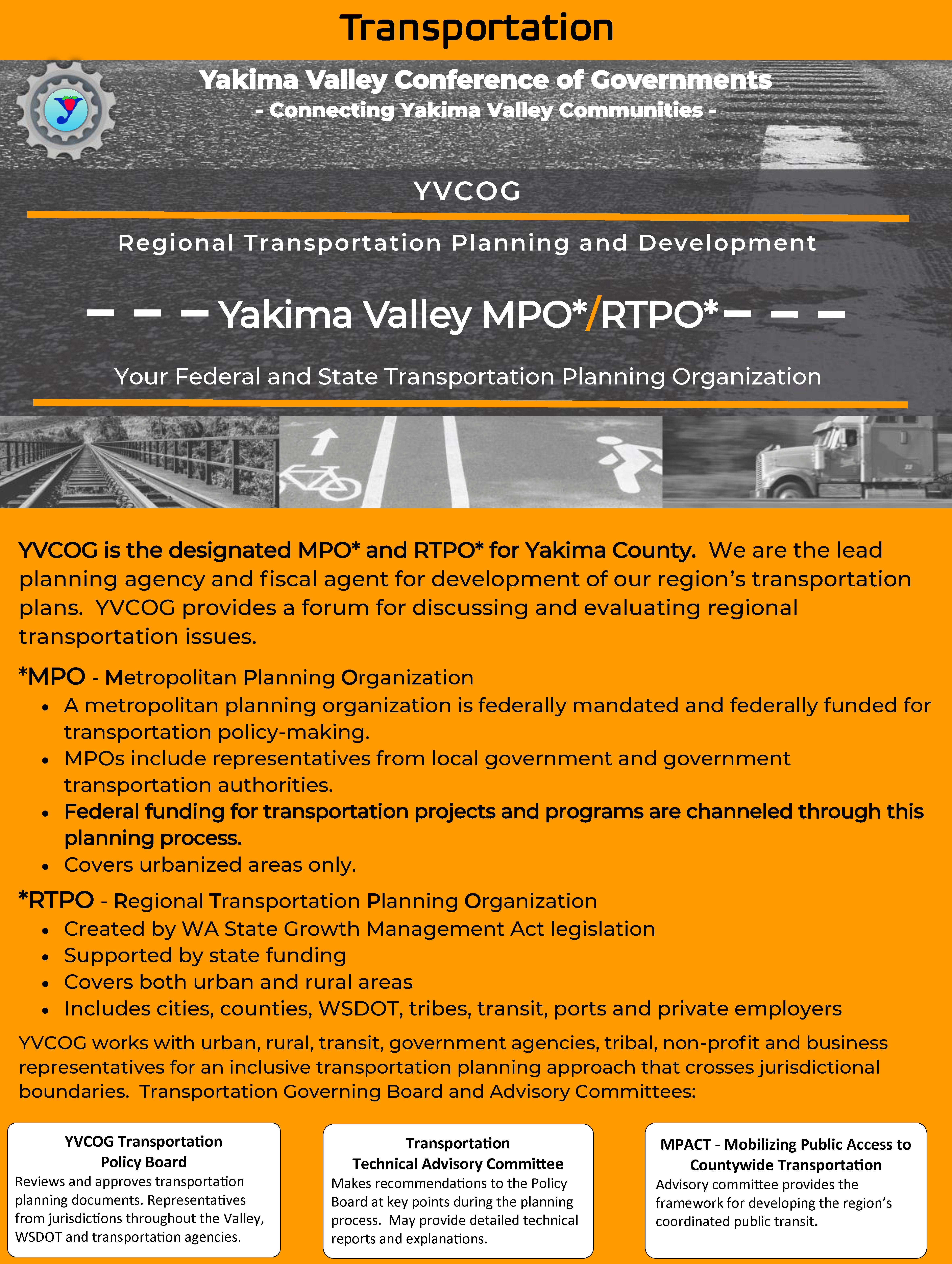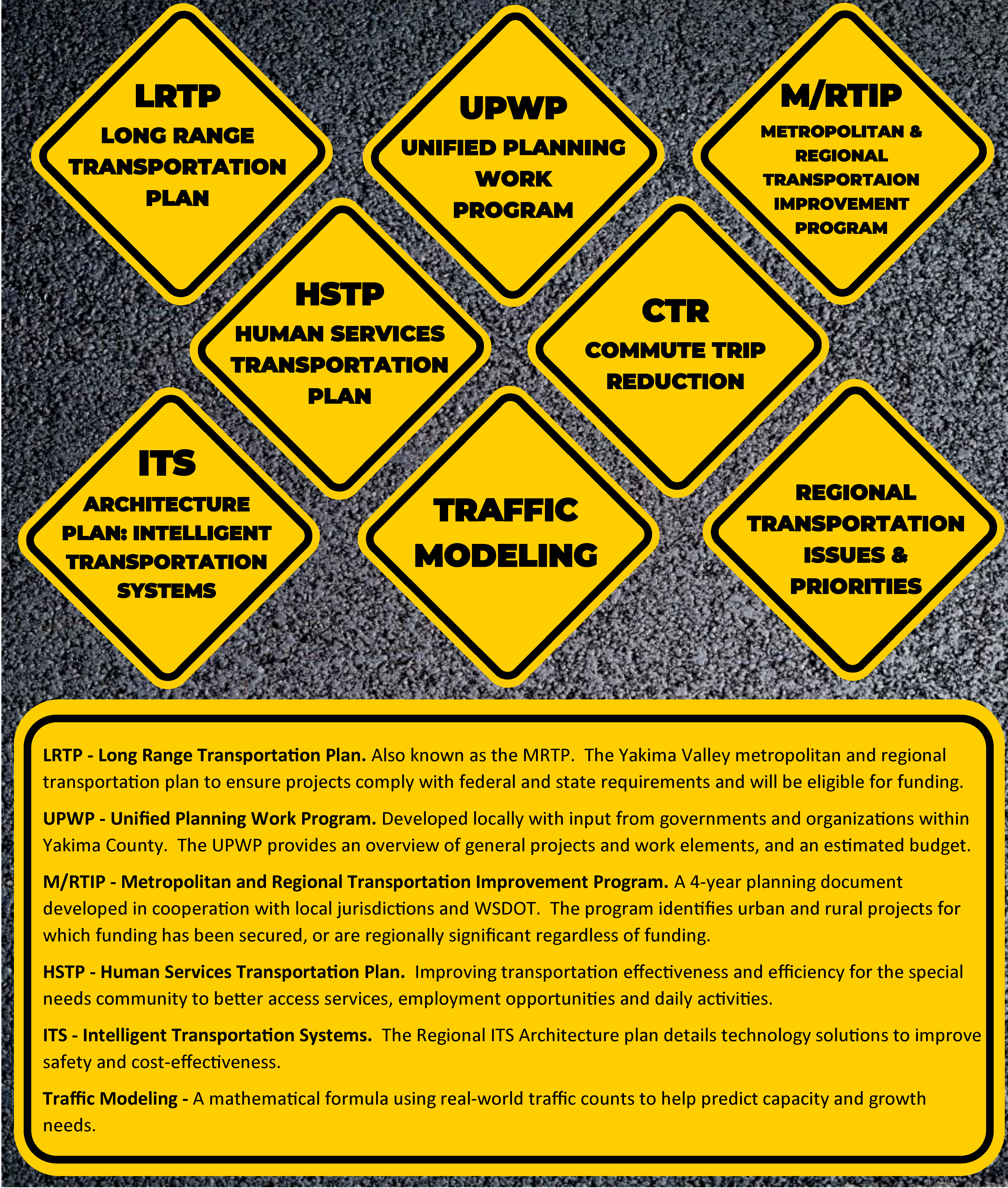

What is the M-RTIP?
The Yakima Valley Metropolitan and Regional Transportation Improvement Program (MTIP/RTIP) is a four-year programming document derived from the more comprehensive six-year Transportation Improvement Program developed and adopted annually by local agencies. Each year the Yakima Valley Conference of Governments (YVCOG) prepares this document in cooperation with local jurisdictions and the Washington State Department of Transportation (WSDOT).
- The MTIP/RTIP is required to:
- Identify urban and rural projects from locally adopted TIPs that are ready for implementation when federal funding has been secured, are WSDOT projects, or are regionally significant regardless of the funding source;
- Demonstrate that projects will not cause or contribute to any new violation of federal air quality standards for carbon monoxide (CO), or particulate matter of 10 micrometers in diameter or less (PM10);
- Demonstrate financial constraint; and
- Demonstrate consistency with RCW 36.70A, Section 70 of the Washington State Growth Management Act requiring transportation planning be coordinated and consistent with local comprehensive plans.
What does the Yakima Valley MPO/RTPO do?
- In general:
- Ensures compliance with state and federal transportation planning requirements to remain eligible for federal transportation project funding.
- Provides a forum for local, regional and state transportation agencies and other interested parties to participate in discussions of regional transportation issues.
What decisions does the MPO/RTPO Policy Board make?
Reviews and approves
- Transportation planning documents (UPWP, TIP, MTP/RTP)
- Contracts with WSDOT for funding (MPO/RTPO, CTR)
- Contracts for transportation planning services (modeling, area studies)
- Contracts for Commute Trip Reduction services (guaranteed ride home, interlocal agreements)
- Transportation project funding
- STP Regional prioritization process and project selection
- CMAQ Prioritization process and project selection
- Transportation enhancement prioritization
- WSDOT Public Transportation Consolidated Grant – regional priorities
What is an RTPO, why were they created and what do they do?
Regional Transportation Planning Organizations (RTPO) are formed by voluntary associations of local governments within geographically contiguous counties. RTPO members may include cities, counties, WSDOT, tribes, ports transportation service providers, and private employers.
RTPOs were authorized as part of the 1990 Growth Management Act to ensure local and regional coordination of transportation plans. RTPO planning must involve cities, counties, WSDOT, transit agencies, ports, and private employers.
- RTPOs are required to:
- Prepare a Regional Transportation Plan
- Certify that countywide planning policies and transportation elements of local comprehensive plans are consistent with the Regional Transportation Plan
- Develop a six-year Regional Transportation Improvement Program
Who are RTPOs?
There are 14 RTPOs covering 38 of the 39 counties in Washington. San Juan County is not part of any RTPO.
How are RTPOs different than Metropolitan Planning Organizations (MPO)?
RTPO
- Created by state legislation (GMA) and supported by state funding
- Covers both urban and rural areas
MPO
- Created by federal legislation and supported by federal funding
- Covers urbanized areas only
MPOs and RTPOs serve the same basic transportation planning functions – develop a long-range plan, coordinate within a region, and prepare a transportation improvement program. The federal MPO and state RTPO requirements of these organizations are complementary. The lead agency for a RTPO is also the lead agency for the MPO within the region (except Lewis-Clark Valley MPO because it is a bi-state organization.)


